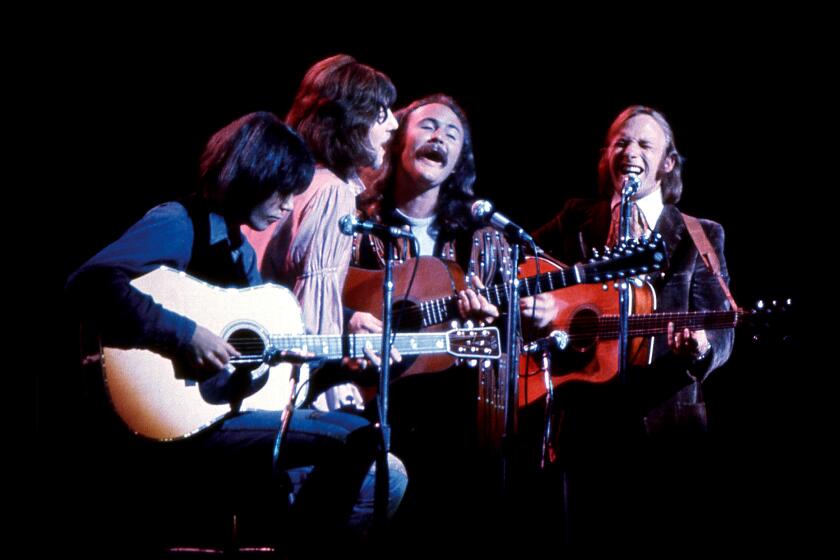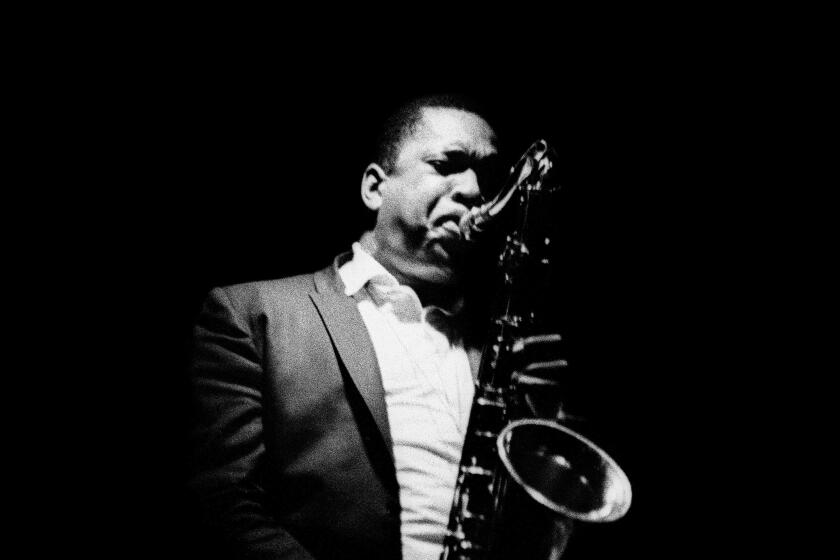Jazz from the past? It sure is a blast
- Share via
The year-end holiday season is always prime time for jazz boxed sets, reissues, offbeat collections and reminiscences. Record companies love the opportunity they provide to help the bottom line. And it turns out to be a win-win situation for jazz fans as well, with the release of newly packaged and annotated classic material, some of it never before available.
The closing quarter of 2007 offered an unusually abundant harvest, with attractive items in several forms of media. Here are a few of the highlights:
--
MILES DAVIS
“THE COMPLETE ‘ON THE CORNER’
SESSIONS” (COLUMBIA LEGACY)
This is the eighth release in Sony Legacy’s boxed set Miles Davis series (others have included “Live at the Plugged Nickel,” “Seven Steps” and “The Complete Jack Johnson Sessions”). And despite the often uneven quality of the music, it affirms Davis’ role as one of jazz’s chief envelope-stretchers. Although he was never as innovative as Duke Ellington nor as radical as Ornette Coleman, each of the creative phases he passed through had a profound effect on the music’s evolving trends. And the “Corner” sessions were no exception.
Recorded between 1972 and 1975 with a 20-man collective of players (Dave Liebman, John McLaughlin, Michael Henderson and Jack DeJohnette among them), the sessions produced a collection of long, rambling takes. Obviously influenced by the avant-garde successes of Coleman, Albert Ayler and others, as well as the pop audience breakthroughs of Jimi Hendrix and Sly and the Family Stone, the music represents Davis’ effort to hold on to his core listeners while establishing relevance with the vital, record-buying baby boomers. But the trumpeter wasn’t particularly successful with either goal this time out, and the “Corner” LP was one of his least admired albums, even though extraordinary moments often surface amid the occasional chaos.
Some of the material included in this six-CD set is also available on “Get Up With It” and, of course, the “On the Corner” album. There’s a great deal of previously unreleased material -- intriguing for hard-core fans, but in some cases often simply underscoring why it was omitted from the original release.
--
NAT KING COLE
“COLLECTORS CHOICE” (EMI)
The nine CDs in this bundle of albums would have made an impressive boxed set. But EMI has chosen to release them as individual items in a two-phase series that will eventually encompass Cole’s entire album output for Capitol Records. This first phase includes 18 Cole LPs on nine CDs. They range from such country-themed sets as “Ramblin’ Rose” and “Dear Lonely Hearts” to a pair of Cole “Espanol” albums, from film music (the Cole-starring “St. Louis Blues”) and instrumentals (“Penthouse Serenade” and “The Piano Style of Nat King Cole”) to a collaboration with the Count Basie Band (“Welcome to the Club”) and the string of 1954-55 hit singles (mostly arranged by Nelson Riddle) on “Ballads of the Day.”
Cole’s artistry is consistent throughout. Whatever the setting, whatever the music, his warm vocal inflections, irresistibly jazz-based phrasing and constant emotional authenticity are ever-present in a collection of performances that are as engaging today as they were the day they were recorded. The second phase of the Cole reissue series begins later this year with CDs of 12 single LPs augmented by bonus tracks.
--
THE GREAT JAZZ TRIO
“OBJECTS APPEAR CLOSER” (TEST OF TIME)
They seemed an unusual grouping when they first got together in the late ‘70s: the elegant, articulate pianist Hank Jones, the unflappable bassist Ron Carter and the youthful, musically outgoing drummer Tony Williams. One could imagine Jones and Carter finding common cause, but Williams had clearly established himself as a leader in the Elvin Jones-inspired trend toward turbulent, aggressive drumming.
The differences turned out to be assets, with Jones drawing more subtle layers of percussion from Williams, and Williams bringing a visceral sense of life to Jones’ up-tempo playing. The results, recorded in Los Angeles, New York and during a concert in Japan, are surprising displays of empathetic music making. The music in the four-CD set -- a fertile mix of originals by all three members and an array of jazz and ballad standards -- is delivered with a constantly engaging improvisational joie de vivre.
--
BILLIE HOLIDAY
“BILLIE HOLIDAY: RARE LIVE RECORDINGS 1934-1959” (ESP-DISK)
This five-CD set belongs in the collection of every jazz fan. Although some of the material has been released in other forms, most of the extensive gathering of songs from Holiday’s appearances in films and concerts, on television and in private recordings, has never before been available. And the insights it provides into the full breadth of her artistry are astonishing -- from a 1934 track from a film short (when she was 19) to a performance at Storyville in New Orleans in April 1959, three months before her death.
There are, for example, five versions, from differing times and places, of “Them There Eyes,” “God Bless the Child” and “Please Don’t Talk About Me When I’m Gone.” Perhaps most fascinating is a recording of a rehearsal with pianist Jimmy Rowles and bassist Artie Shapiro in which Holiday discusses how she wants an arrangement to sound, reminisces about her past history and jokes about her dislike of the number 13.
Aside from a few typos and one glaring error, the program notes provide a useful overview of Holiday’s entire career, contextualizing each of the included tracks in this utterly compelling recording.
--
VARIOUS ARTISTS
“JAZZ ICONS”
(REELIN’ IN THE YEARS PRODUCTIONS)
Here’s an object demonstration, over the course of eight DVDs, of the extraordinary visual appeal of jazz, without the music-video staples of garish special effects and fast cutting. The music, filmed with great respect for the players, easily holds its own. Featured in this second series of “Jazz Icons” are John Coltrane, Charles Mingus, Duke Ellington, Sarah Vaughan, Dave Brubeck, Wes Montgomery and Dexter Gordon. The high points come fast and furious: two versions of Coltrane doing “My Favorite Things,” a trio of Mingus performances in Germany featuring the incomparable saxophonist Eric Dolphy a few months before his death; the classic Ellington band in the late ‘50s, playing “Mood Indigo,” “Caravan” and more; Vaughan’s growing maturity in performances reaching from 1958 to 1964. No extra features other than well written program notes, but they’re not needed for these self-explanatory displays of great jazz artists at work. Although the discs are available as individual DVDs, the boxed set includes an additional DVD with bonus performances from Gordon, Coltrane and Vaughan.
--
“IMPROVISATION” (EAGLE EYE MEDIA)
You say you don’t like the idea of Britney Spears lip-syncing? How about Charlie Parker, Lester Young and Coleman Hawkins horn-syncing to recordings of their improvised solos? Sad to say, that’s exactly what was done by producer-impresario Norman Granz in the production of two key elements in this otherwise fine double-DVD set of jazz performances from the ‘50s through the late ‘70s.
The first key element is the short “Jammin’ the Blues.” Directed by Gjon Mili and nominated for a 1944 best short film Oscar, it is actually a precursor of MTV, in the sense that its production, filled with atmospheric lighting and hovering cigarette smoke, has far more to do with visual fantasy than it does with the music itself. The second element is a session in which Hawkins and Parker -- a truly legendary duo -- are obliged, as were the players in “Jammin’ the Blues,” to attempt to match the blowing and fingering of their horns with their own recorded choruses.
Granz’s justification for the whole charade was that the sound environment in the photo studio was inadequate for audio recording. Fortunately, “Improvisation” has enough stellar moments in which players are actually playing while they’re being filmed: the Duke Ellington trio in 1966; Montreux Jazz Festival sessions from 1977 featuring, among others, Oscar Peterson, Dizzy Gillespie, Count Basie and Clark Terry. But hovering over the proceedings is the sense of missed opportunity, of the possibility of seeing and hearing Parker and Hawkins in action, whatever the quality of the sound.
More to Read
The biggest entertainment stories
Get our big stories about Hollywood, film, television, music, arts, culture and more right in your inbox as soon as they publish.
You may occasionally receive promotional content from the Los Angeles Times.










